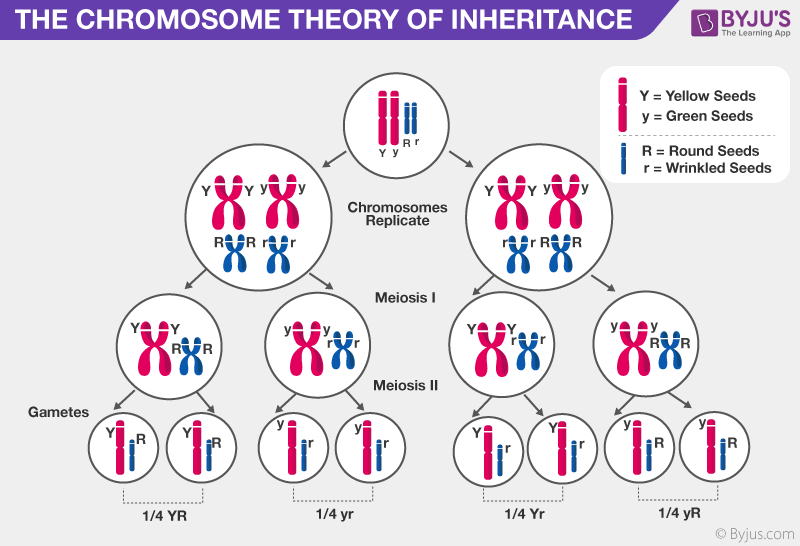What are Chromosomes?
Chromosomes are a thread-like structure of nucleic acids and protein located within the nucleus of the living cells and are mainly involved in carrying genetic information in the form of genes.

The Chromosomal Theory of Inheritance
The chromosomal theory of inheritance was given by Boveri and Sutton in the early 1900s. It is the fundamental theory of genetics. According to this theory, genes are the units of heredity and are found in the chromosomes.
Chromosomal Theory of Inheritance came into existence long after Mendelian genetics. During Mendel’s experimentation, the society was not acceptable to such drastic changes in their scientific ideas. They could not believe the existence of such discrete factors such as genes which would segregate without mixing as this did not support their idea of the constant changes leading to evolution. Moreover, the means of communication was poor at that time as a result of which, the information could not be conveyed to the masses. Also, Mendel’s mathematical approach to prove biological laws was unacceptable.
As time passed, scientists Vries, Correns and Tschermak discovered chromosomes which existed inside the nucleus. Sutton and Boveri discovered observed the behaviour of the chromosomes when the cells were divided. With the advancements in the microscope, this task became easier. Hence, they proved Mendel’s laws with the help of chromosomal movement. They showed the segregation of the chromosomes during the Anaphase of cell division. The idea of chromosomal segregation combined with the Mendelian principles gave rise to the chromosomal theory of Inheritance. The work was further carried forward and proved by T.H. Morgan, who used Drosophila melanogaster to show how sexual reproduction gave rise to variations.

Chromosomal theory: Linkage and Genetic Recombination
Morgan observed that while crossing a set of characteristics, two genes did not segregate as per Mendel’s law. If two genes were present on the same chromosome, the probability of getting a parental combination was much higher in the next generation compared to the non-parental combination. This physical association of genes was termed as linkage. The term genetic recombination described the non-parental gene combinations in a dihybrid cross. Once, linked genes were discovered, the frequency of linked genes also influenced the appearance of traits in the next generation. A student of Morgan, Sturtevant discovered the position of linked genes on a chromosome by calculating their frequency of genetic recombination by the process of gene mapping. This method of generating a link map was extensively used during the Human Genome Project.
Also, read Human Genome Project
Observations of Chromosomal Theory of Inheritance
The Chromosomal Theory of Inheritance supports Mendel’s laws. Listed below are the observations of this theory:
- During the process of cell division-meiosis, the pairs of homologous chromosome move as discrete structures, which are independent of other pairs of chromosomes.
- There is a random distribution of chromosomes into the pre-gametes from each homologous pair.
- Each parent synthesizes gametes, which constitute only half of their chromosomal complement.
- Even though female (egg) and male (sperm) gametes differ in their size and morphology, they have the same number of chromosomes, submitting equal genetic contributions from each parent.
- The gametic chromosomes fuse during fertilization to produce offspring with the same number of a chromosome as their parents.
Some Important Questions on Chromosomal Theory of Inheritance
- Who discovered chromosomes?
Carl Wilhelm von Nageli, a Swiss botanist discovered chromosomes and he was a first person to study about the cell divisions
- What is the chromosomal theory of inheritance?
It is the fundamental theory of genetics which recognizes chromosomes as the carriers of genetic material.
- Who proposed the chromosomal theory of inheritance?
Theodor Boveri and Walter Sutton are the two scientists who were credited with developing the Chromosomal Theory of Inheritance.
- What is Mutations?
The mutation is defined as the change or the permanent alteration of the nucleotide sequence of the genome of an organism.
Stay tuned with BYJU’S to know more in detail about the chromosomal theory of inheritance.

Comments